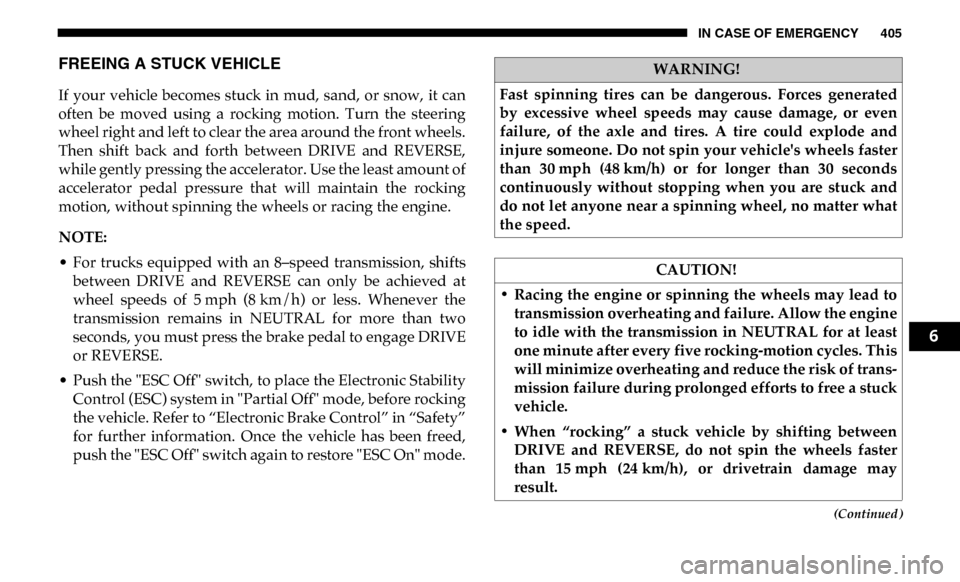pedal Ram 4500 Chassis Cab 2019 Repair Manual
[x] Cancel search | Manufacturer: RAM, Model Year: 2019, Model line: 4500 Chassis Cab, Model: Ram 4500 Chassis Cab 2019Pages: 607, PDF Size: 10.72 MB
Page 406 of 607

404 IN CASE OF EMERGENCY
Manual Park Release Pull Strap
Follow these steps to activate the Manual Park Release:
1. Firmly apply the parking brake.
2. Using a small screwdriver or similar tool, remove the Manual Park Release access cover, which is just above the
parking brake release handle, below and to the left of the
steering column.
3. Press and maintain firm pressure on the brake pedal. 4. Using the screwdriver or similar tool, push the Manual
Park Release lever locking tab (just below the middle of
the lever) to the right.
5. While holding the locking tab in the disengaged position, pull the tether strap to rotate the lever rearward, until it
locks in place pointing towards the driver's seat. Release
the locking tab and verify that the Manual Park Release
lever is locked in the released position.
6. The vehicle is now out of PARK (P) and can be towed. Release the parking brake only when the vehicle is
securely connected to a tow vehicle.
To Reset The Manual Park Release:
1. Push the locking tab to the right, to unlock the lever.
2. Rotate the Manual Park Release lever forward to its orig -
inal position, until the locking tab snaps into place to
secure the lever.
3. Pull gently on the tether strap to confirm that the lever is locked in its stowed position.
4. Re-install the access cover.
Page 407 of 607

IN CASE OF EMERGENCY 405
(Continued)
FREEING A STUCK VEHICLE
If your vehicle becomes stuck in mud, sand, or snow, it can
often be moved using a rocking motion. Turn the steering
wheel right and left to clear the area around the front wheels.
Then shift back and forth between DRIVE and REVERSE,
while gently pressing the accelerator. Use the least amount of
accelerator pedal pressure that will maintain the rocking
motion, without spinning the wheels or racing the engine.
NOTE:
• For trucks equipped with an 8–speed transmission, shiftsbetween DRIVE and REVERSE can only be achieved at
wheel speeds of 5 mph (8 km/h) or less. Whenever the
transmission remains in NEUTRAL for more than two
seconds, you must press the brake pedal to engage DRIVE
or REVERSE.
• Push the "ESC Off" switch, to place the Electronic Stability Control (ESC) system in "Partial Off" mode, before rocking
the vehicle. Refer to “Electronic Brake Control” in “Safety”
for further information. Once the vehicle has been freed,
push the "ESC Off" switch again to restore "ESC On" mode.
WARNING!
Fast spinning tires can be dangerous. Forces generated
by excessive wheel speeds may cause damage, or even
failure, of the axle and tires. A tire could explode and
injure someone. Do not spin your vehicle's wheels faster
than 30 mph (48 km/h) or for longer than 30 seconds
continuously without stopping when you are stuck and
do not let anyone near a spinning wheel, no matter what
the speed.
CAUTION!
• Racing the engine or spinning the wheels may lead to transmission overheating and failure. Allow the engine
to idle with the transmission in NEUTRAL for at least
one minute after every five rocking-motion cycles. This
will minimize overheating and reduce the risk of trans -
mission failure during prolonged efforts to free a stuck
vehicle.
• When “rocking” a stuck vehicle by shifting between DRIVE and REVERSE, do not spin the wheels faster
than 15 mph (24 km/h), or drivetrain damage may
result.
6
Page 440 of 607

438 SERVICING AND MAINTENANCE
(Continued)
Brake System
In order to assure brake system performance, all brake
system components should be inspected periodically. Refer
to the “Maintenance Plan” in this section for the proper
maintenance intervals.
Fluid Level Check — Brake Master Cylinder
The fluid level of the master cylinder should be checked
when performing under the hood service or immediately if
the brake system warning lamp indicates system failure.
If necessary, add fluid to bring level within the designated
marks on the side of the reservoir of the brake master
cylinder. Be sure to clean the top of the master cylinder area
before removing cap.With disc brakes the fluid level can be expected to fall as the
brake linings wear. However, an unexpected drop in fluid
level may be caused by a leak and a system check should be
conducted.
Refer to “Fluids And Lubricants” in “Technical Specifica
-
tions” for further information.
WARNING!
Riding the brakes can lead to brake failure and possibly
a collision. Driving with your foot resting or riding on
the brake pedal can result in abnormally high brake
temperatures, excessive lining wear, and possible brake
damage. You would not have your full braking capacity
in an emergency.
WARNING!
• Use only manufacturer's recommended brake fluid. Refer to “Fluids And Lubricants” in “Technical Speci -
fications” for further information. Using the wrong
type of brake fluid can severely damage your brake
system and/or impair its performance. The proper type
of brake fluid for your vehicle is also identified on the
original factory installed hydraulic master cylinder
reservoir.
• To avoid contamination from foreign matter or mois -
ture, use only new brake fluid or fluid that has been in
a tightly closed container. Keep the master cylinder
reservoir cap secured at all times. Brake fluid in a open
container absorbs moisture from the air resulting in a
lower boiling point. This may cause it to boil unexpect -
edly during hard or prolonged braking, resulting in
sudden brake failure. This could result in a collision.
Page 442 of 607

440 SERVICING AND MAINTENANCE
Fluid Level Check — Eight-Speed Transmission
The fluid level is preset at the factory and does not require
adjustment under normal operating conditions. Routine
fluid level checks are not required, therefore the transmis-
sion has no dipstick. An authorized dealer can check your
transmission fluid level using special service tools.
If you notice fluid leakage or transmission malfunction, visit
an authorized dealer immediately to have the transmission
fluid level checked. Operating the vehicle with an improper
fluid level can cause severe transmission damage. Fluid Level Check — Six-Speed Transmission
It is best to check the fluid level when the transmission is at
normal operating temperature (158-176°F / 70-80°C). This
normally occurs after at least 15 miles (25 km) of driving. At
normal operating temperature the fluid cannot be held
comfortably between the fingertips. You can read the trans
-
mission sump temperature in the instrument cluster screen
(refer to “Instrument Cluster Display” for further informa -
tion).
Use the following procedure to check the transmission fluid
level properly:
1. Monitor the transmission temperature using the instru -
ment cluster display, and operate the vehicle as required
to reach the normal operating temperature. If the trans-
mission is not functioning properly, or the vehicle cannot
be driven, see the NOTE and CAUTION below about
checking the fluid level at colder temperatures.
2. Park the vehicle on level ground.
3. Run the engine at normal idle speed for at least 60 seconds, and leave the engine running for the rest of this
procedure.
4. Fully apply the parking brake, and press the brake pedal.
CAUTION!
Do not use chemical flushes in your transmission as the
chemicals can damage your transmission components.
Such damage is not covered by the New Vehicle Limited
Warranty.
CAUTION!
If a transmission fluid leak occurs, visit an authorized
dealer immediately. Severe transmission damage may
occur. An authorized dealer has the proper tools to adjust
the fluid level accurately.
Page 478 of 607

476 TECHNICAL SPECIFICATIONS
BRAKE SYSTEM
If power assist is lost for any reason (for example, repeated
brake applications with the engine off), the brakes will still
function. However, you will experience a substantial
increase in braking effort to stop the vehicle.
If either the front or rear hydraulic system loses normal
braking capability, the remaining system will still function
with some loss of overall braking effectiveness. This will be
evident by increased pedal travel during application, greater
pedal force required to slow or stop, and activation of the
“Brake Warning Light” and the “ABS Warning Light” (if
equipped) during brake use.
The brake system power assist is provided by a hydro-boost
unit which shares fluid with the power steering system. You
may experience some clicking or hissing noises from the
hydro-boost system during hard braking conditions.
NOTE:
Under cold temperatures, pedal effort will be higher than
normal until the power steering fluid reaches operating
temperature.
Hydraulic Brake Assist
The brake system power assist is provided by a hydro-boost
unit which shares fluid with the power steering system. You
may experience some clicking or hissing noises from the
hydro-boost system during hard braking conditions.
NOTE:
Under cold temperatures, pedal effort will be higher than
normal until the power steering fluid reaches operating
temperature.
WHEEL AND TIRE TORQUE SPECIFICATIONS
Proper lug nut/bolt torque is very important to ensure that
the wheel is properly mounted to the vehicle. Any time a
wheel has been removed and reinstalled on the vehicle, the
lug nuts/bolts should be torqued using a properly calibrated
torque wrench using a high quality six sided (hex) deep wall
socket.
Page 592 of 607

INDEX
A
Adaptive Cruise Control (ACC) (Cruise Control) ............. 288
Adding Engine Coolant (Antifreeze) ................................... 435
Adding Fuel ............................................................................. 336
Additives, Fuel ........................................................................ 480
Adjust Down....................................................................................... 42
Forward .................................................................................. 42
Rearward ................................................................................ 42
Up ............................................................................................ 42
Adjustable Pedals...................................................................... 55
Air Bag Air Bag Operation ............................................................... 205Air Bag Warning Light ....................................................... 203
Enhanced Accident Response ................................... 212, 409
Event Data Recorder (EDR) ............................................... 409
If Deployment Occurs ........................................................ 211
Knee Impact Bolsters .......................................................... 206Maintaining Your Air Bag System.................................... 213
Maintenance......................................................................... 213
Transporting Pets ................................................................ 240
Air Bag Light ........................................................... 146, 203, 241
Air Cleaner, Engine (Engine Air Cleaner Filter) ................ 420
Air Conditioner Maintenance ............................................... 421 Air Conditioner Refrigerant ..........................................421, 422
Air Conditioner System..........................................................421
Air Conditioning ................................................................. 77, 88
Air Conditioning Filter .....................................................91, 423
Air Conditioning System .........................................................89
Air Conditioning, Operating Tips ..........................................89
Air Filter ...................................................................................420
Air Pressure Tires .......................................................................................455
Alarm Panic ........................................................................................18
Security Alarm ...............................................................30, 148
Alterations/Modifications Vehicle.....................................................................................14
Android Auto ..........................................................................579
Antifreeze (Engine Coolant) ..................................................434 Capacites...............................................................................483
Disposal ................................................................................436
Anti-Lock Brake System (ABS) .............................................161
Anti-Lock Warning Light.......................................................154
Apple CarPlay .........................................................................581
Assist, Hill Start .......................................................................164
Audio Systems (Radio)........................................................... 487
Auto Down Power Windows ..................................................92
Page 600 of 607

598
O
Occupant Restraints................................................................ 187
Octane Rating, Gasoline (Fuel) ............................................. 479
Oil Filter, Change .................................................................... 419
Oil Filter, Selection.................................................................. 419
Oil Pressure Light ................................................................... 148
Oil Reset ................................................................................... 130
Oil, Engine ....................................................................... 418, 484 Capacity ................................................................................ 483
Change Interval ................................................................... 418Dipstick................................................................................. 416
Disposal ................................................................................ 419
Filter .............................................................................. 419, 484
Filter Disposal ...................................................................... 419
Identification Logo.............................................................. 418Materials Added To ............................................................ 419
Pressure Warning Light ..................................................... 148
Recommendation ................................................................ 418
Synthetic ............................................................................... 419Viscosity ............................................................................... 419
Onboard Diagnostic System .................................................. 158
Operating Precautions............................................................ 158
Operator Manual Owner's Manual ............................................................ 13, 589
Outside Rearview Mirrors ....................................................... 58
Overdrive ................................................................................. 263 Overdrive OFF Switch............................................................263
Overheating, Engine ...............................................................401 P
Paint Care .................................................................................470
Panic Alarm ...............................................................................18
Parking Brake ..........................................................................252
ParkSense System, Rear .................................................309, 317
Passive Entry..............................................................................34
Pedals, Adjustable .....................................................................55
Personalized Main Menu .......................................................487
Pets ............................................................................................240
Placard, Tire And Loading Information ..............................450
Power Distribution Center (Fuses)................................................381
Door Locks .............................................................................33
Mirrors ....................................................................................59
Outlet (Auxiliary Electrical Outlet) ..........................117, 119 Seats.........................................................................................42
Sliding Rear Window............................................................94
Steering ...................................................................59, 283, 284 Take-Off Adapter ................................................................281
Take-Off Operation .............................................................281
Windows.................................................................................92
Power Seats Down .......................................................................................42
Forward ..................................................................................42